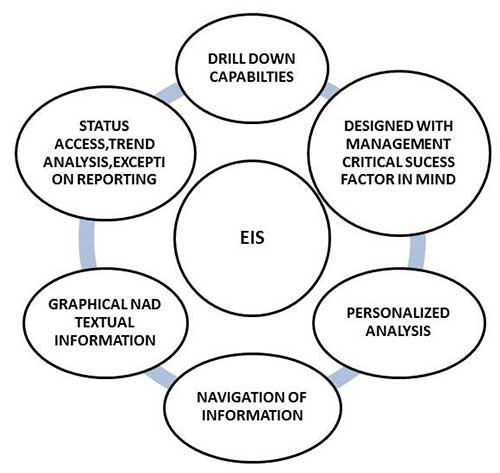An Executive Information System can be defined as a specialized Decision Support System. This type of the system generally includes the various hardware, software, data, procedures and the people. With the help of all this, the top level executives get a great support in taking and performing the various types of the decisions. The executive information system plays a very important role in obtaining the data from the different sources, then help in the integration and the aggregation of this data. After performing these steps the resulting information is displayed in such a pattern that is very easy to understand.
Executive information system is ‘a computer based system that serves the information that is needed by the various top executives. It provides very rapid access to the timely information and also offers the direct access to the different management reports.’
Executive Information System is very user friendly in the nature. It is supported at a large extent by the graphics.
Executive support system can be defined as the comprehensive executive support system that goes beyond the Executive Information System and also includes communications, office automation, analysis support etc.

According to Watson, Executive Information System / executive support system depends on some of the factors that can be summarized as the follows
- Internal factors
- Need for the timely information.
- Need for the improved communications.
- Need for the access to the operational data.
- Need for the rapid status updates on the various business activities.
- Need for the access to the corporate database.
- Need for very accurate information.
- Need for the ability to identify the various historical trends.
- External Factors
- Increasing and intensifying the global competition.
- Rapidly changing the business environment.
- Need to be more proactive.
- Need to access the external database.
- Increasing the various government regulations.
Characteristics of the Executive Information System
- Informational characteristics
- Flexibility and ease of use
- Provides the timely information with the short response time and also with the quick retrieval
- Produces the correct information
- Produces the relevant information
- Produces the validated information
- User interface/orientation characteristics
- Consists of the sophisticated self help
- Contains the user friendly interfaces consisting of the graphic user
- Can be used from many places
- Offers secure reliable, confidential access along with the access procedure
- Is very much customized
- Suites the management style of the individual executives
- Managerial / executive characteristics
- Supports the over all vision, mission and the strategy
- Provides the support for the strategic management
- Sometimes helps to deal with the situations that have a high degree of risk
- Is linked to the value added business processes
- Supports the need/ access for/ to the external data/ databases
- Is very much result oriented in the nature
Capabilities of Executive Information System
(i) Helps in accessing the aggregated or macro or global information.
(ii) Provides the user with an option to use the external data extensively.
(iii) Enables analysis of the address and the hoc queries.
(iv) Shows the trends, the ratios and the various deviations.
(v) Helps in incorporating the graphic and the text in the same display, which helps to have a better view.
(vi) It helps in the assessment of the historical as also the latest data.
(vii) Problem indicators can be highlighted with the help of the Executive Information System / executive support system.
(viii) Open ended problem explanation with the written interpretations can be done with the help of the Executive Information System / executive support system.
(ix) Offers management by the exception reports.
(x) Utilizes the hyper text and the hyper media.
(xi) Offers generalized computing.
(xii) Offers telecommunications capacity.
Benefits of Executive Information System
(i) Achievement of the various organizational objectives.
(ii) Facilitates access to the information by integrating many sources of the data.
(iii) Facilitates broad, aggregated perspective and the context.
(iv) Offers broad highly aggregated information.
(v) User’s productivity is also improved to a large extent.
(vi) Communication capability and the quality are increased.
(vii) Provides with the better strategic planning and the control.
(viii) Facilitates pro-active rather than a reactive response.
(ix) Provides the competitive advantage.
(x) Encourages the development of a more open and active information culture.
(xi) The cause of a particular problem can be founded.